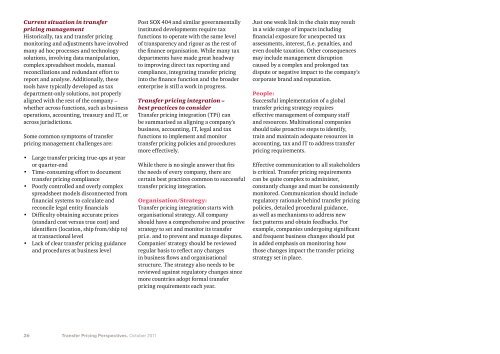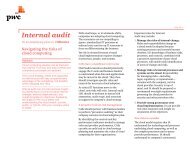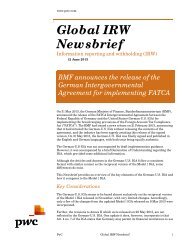Transfer pricing perspectives: Winds of Change - PwC
Transfer pricing perspectives: Winds of Change - PwC
Transfer pricing perspectives: Winds of Change - PwC
Create successful ePaper yourself
Turn your PDF publications into a flip-book with our unique Google optimized e-Paper software.
Current situation in transfer<strong>pricing</strong> managementHistorically, tax and transfer <strong>pricing</strong>monitoring and adjustments have involvedmany ad hoc processes and technologysolutions, involving data manipulation,complex spreadsheet models, manualreconciliations and redundant effort toreport and analyse. Additionally, thesetools have typically developed as taxdepartment-only solutions, not properlyaligned with the rest <strong>of</strong> the company –whether across functions, such as businessoperations, accounting, treasury and IT, oracross jurisdictions.Some common symptoms <strong>of</strong> transfer<strong>pricing</strong> management challenges are:• Large transfer <strong>pricing</strong> true-ups at yearor quarter-end• Time-consuming effort to documenttransfer <strong>pricing</strong> compliance• Poorly controlled and overly complexspreadsheet models disconnected fromfinancial systems to calculate andreconcile legal entity financials• Difficulty obtaining accurate prices(standard cost versus true cost) andidentifiers (location, ship from/ship to)at transactional level• Lack <strong>of</strong> clear transfer <strong>pricing</strong> guidanceand procedures at business levelPost SOX 404 and similar governmentallyinstituted developments require taxfunctions to operate with the same level<strong>of</strong> transparency and rigour as the rest <strong>of</strong>the finance organisation. While many taxdepartments have made great headwayto improving direct tax reporting andcompliance, integrating transfer <strong>pricing</strong>into the finance function and the broaderenterprise is still a work in progress.<strong>Transfer</strong> <strong>pricing</strong> integration –best practices to consider<strong>Transfer</strong> <strong>pricing</strong> integration (TPi) canbe summarised as aligning a company'sbusiness, accounting, IT, legal and taxfunctions to implement and monitortransfer <strong>pricing</strong> policies and proceduresmore effectively.While there is no single answer that fitsthe needs <strong>of</strong> every company, there arecertain best practices common to successfultransfer <strong>pricing</strong> integration.Organisation/Strategy:<strong>Transfer</strong> <strong>pricing</strong> integration starts withorganisational strategy. All companyshould have a comprehensive and proactivestrategy to set and monitor its transferpri.e. and to prevent and manage disputes.Companies' strategy should be reviewedregular basis to reflect any changesin business flows and organisationalstructure. The strategy also needs to bereviewed against regulatory changes sincemore countries adopt formal transfer<strong>pricing</strong> requirements each year.Just one weak link in the chain may resultin a wide range <strong>of</strong> impacts includingfinancial exposure for unexpected taxassessments, interest, fi.e. penalties, andeven double taxation. Other consequencesmay include management disruptioncaused by a complex and prolonged taxdispute or negative impact to the company'scorporate brand and reputation.People:Successful implementation <strong>of</strong> a globaltransfer <strong>pricing</strong> strategy requireseffective management <strong>of</strong> company staffand resources. Multinational companiesshould take proactive steps to identify,train and maintain adequate resources inaccounting, tax and IT to address transfer<strong>pricing</strong> requirements.Effective communication to all stakeholdersis critical. <strong>Transfer</strong> <strong>pricing</strong> requirementscan be quite complex to administer,constantly change and must be consistentlymonitored. Communication should includeregulatory rationale behind transfer <strong>pricing</strong>policies, detailed procedural guidance,as well as mechanisms to address newfact patterns and obtain feedbacks. Forexample, companies undergoing significantand frequent business changes should putin added emphasis on monitoring howthose changes impact the transfer <strong>pricing</strong>strategy set in place.26 <strong>Transfer</strong> Pricing Perspectives. October 2011
















